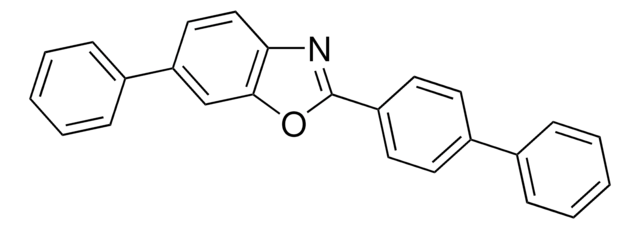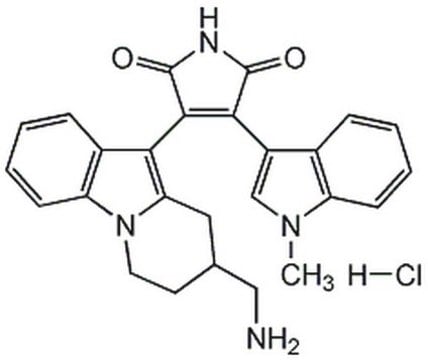P3754
1,4-Bis(5-phenyl-2-oxazolyl)benzene
BioReagent, suitable for scintillation
동의어(들):
1,4-Bis(5-phenyl-2-oxazolyl)benzene, 2,2′-p-Phenylene-bis(5-phenyloxazole), Di(phenyl-5-oxazolyl-2)-1,4-benzene, POPOP
로그인조직 및 계약 가격 보기
모든 사진(5)
About This Item
실험식(Hill 표기법):
C24H16N2O2
CAS Number:
Molecular Weight:
364.40
Beilstein:
325741
EC Number:
MDL number:
UNSPSC 코드:
41116105
PubChem Substance ID:
NACRES:
NA.32
추천 제품
제품 라인
BioReagent
형태
powder
mp
242-246 °C (lit.)
적합성
suitable for scintillation
SMILES string
c1ccc(cc1)-c2cnc(o2)-c3ccc(cc3)-c4ncc(o4)-c5ccccc5
InChI
1S/C24H16N2O2/c1-3-7-17(8-4-1)21-15-25-23(27-21)19-11-13-20(14-12-19)24-26-16-22(28-24)18-9-5-2-6-10-18/h1-16H
InChI key
MASVCBBIUQRUKL-UHFFFAOYSA-N
유사한 제품을 찾으십니까? 방문 제품 비교 안내
일반 설명
1,4-Bis(5-phenyl-2-oxazolyl) benzene, also known as POPOP, is a well-known scintillation luminophore. It is an efficient fluorescent organic compound with high stokes shift. The POPOP dye is photostable in polar protic and polar aprotic solvents. The resulting photochemical quantum yield and the photodecomposition rate depend on the solvent′s electron affinity.
애플리케이션
1,4-Bis(5-phenyl-2-oxazolyl) benzene or POPOP is widely used to detect radioactivity by scintillation counting.
특징 및 장점
1,4-Bis(5-phenyl-2-oxazolyl) benzene or POPOP has the following advantages:
- High fluorescence quantum yield.
- High molar absorptivity.
- Large Stokes Shift.
- High Photostability in most organic solvents.
관련 제품
신호어
Warning
유해 및 위험 성명서
Hazard Classifications
Acute Tox. 4 Oral - Eye Irrit. 2
Storage Class Code
11 - Combustible Solids
WGK
WGK 2
Flash Point (°F)
Not applicable
Flash Point (°C)
Not applicable
개인 보호 장비
dust mask type N95 (US), Eyeshields, Gloves
시험 성적서(COA)
제품의 로트/배치 번호를 입력하여 시험 성적서(COA)을 검색하십시오. 로트 및 배치 번호는 제품 라벨에 있는 ‘로트’ 또는 ‘배치’라는 용어 뒤에서 찾을 수 있습니다.
Juliana Oliveira et al.
ACS applied materials & interfaces, 10(15), 12904-12912 (2018-03-28)
Organic photodetectors (PDs) based on printing technologies will allow to expand the current field of PD applications toward large-area and flexible applications in areas such as medical imaging, security, and quality control, among others. Inkjet printing is a powerful digital
N S Kudryasheva et al.
Luminescence : the journal of biological and chemical luminescence, 16(3), 243-246 (2001-06-16)
The involvement of upper electron-excited states in bacterial bioluminescence process was studied with excitation energy-accepting molecules. The fluorescent aromatic compounds, anthracene and 1.4-bis(5-phenyloxazol-2-yl)benzene, were chosen. Energies of their lowest excited singlet states are higher than the energy of the analogous
Xiaohui Hou et al.
Analytical biochemistry, 368(1), 100-110 (2007-06-15)
In this study, micron-sized poly(styrene-co-glycidyl methacrylate) (PSt-GMA) fluorescent microspheres of 5.1microm in diameter were synthesized via dispersion polymerization of styrene and glycidyl methacrylate in the presence of 1,4-bis(5-phenyloxazol-2-yl) benzene (POPOP), which provided surface functional groups for covalent immobilization of enzymes.
Kadir Aslan et al.
Analytical chemistry, 80(19), 7304-7312 (2008-09-04)
The use of zinc thin films deposited onto glass supports for surface plasmon coupled fluorescence (SPCF) over a broad 200 nm wavelength range is demonstrated. Fresnel calculations performed in the ultraviolet and visible spectral range are predicted to generate surface
[A method for the recovery of dioxane, naphthalene, PPO and POPOP from used scintillation solutions].
G Merkel et al.
Zeitschrift fur medizinische Laboratoriumsdiagnostik, 28(5), 279-279 (1987-01-01)
자사의 과학자팀은 생명 과학, 재료 과학, 화학 합성, 크로마토그래피, 분석 및 기타 많은 영역을 포함한 모든 과학 분야에 경험이 있습니다..
고객지원팀으로 연락바랍니다.









